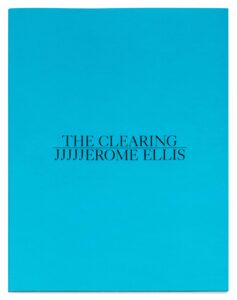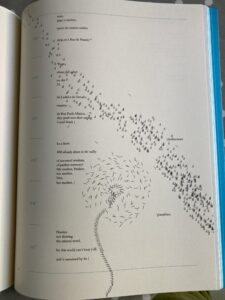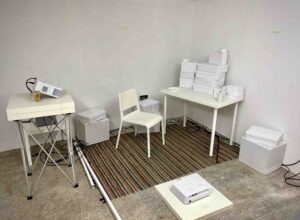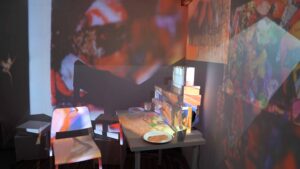Something serendipitous has welled up in my PhD research. An unexpected connection has sparked and fused. This connection is all about time, or rather its disruption, through usurping societal expectations of chronological time. It spans between my research area and the creative approach. This connection is opening up possibilities for thinking creatively around disfluency.
The Stories Beyond Words project brings together a group of people with diverse communication impairments to co-create immersive audio-visual installations. These artworks aim to challenge societal preconceptions about non-normative voices. The group are collaborating to create their own radical self-representations of their communication, to creatively confront ‘dyslistening’[i]. Across communities of people with non-normative voices, there is a push back against expectations to communicate within a convenient-for-others timeframe. Disfluency of voice is being increasingly held as a positive disruption of societal norms around time. Within my PhD research this concept has been steadily evolving as a core concept.
The research is creative and practice-based. That is, we are learning and developing insights through the processes of creating and making. Collaboration is key – we bring together our shared experiences as a group. The collaboration spans across co-design (developing concepts and messages), co-production (planning the project’s direction) and co-creating (making the artworks). It’s important to say here that I don’t have a communication impairment myself, but I am neurodiverse, which brings its own edge to the project. Since early on, I have worked closely with Emily, Jamie and Emma to develop the research plan. They have shared their communication expertise. We have spent much time in cafes working together, and I have experienced how ‘dyslisteners’ interact with them, oblivious to the fact they are co-designing PhD research.
Our group has now grown to ten. We started workshops in October 2022, and have met online four times so far. These workshops have explored ideas around what we want to create and the impact we want to make. There have been many insightful discussions around experiences of communication difference, with many themes emerging. Time keeps coming up as the intertwining connection, as a ‘force’ that shapes these experiences. These quotes from the workshops show the impact time has:
“People don’t always know what I’m saying, it’s annoying when they assume they know and say ‘yeah, yeah, yeah’… I think they do it to save time, not to help me. It’s rude not to ask to repeat, to just pretend.” Emily
“People don’t have time, or so they say. If we can get over something about that it would be great.” Christine
“Other people’s perception of time is key. I’d like people to ask [when I’m using my communication device] ‘would you like me to wait, or shall we come back to you?’. It can take ages to type, especially if I’m cold or experiencing strong emotions. I’d like to see a world where people know I need time to say what I need to say.” Jamie
Now – let’s consider time’s impact upon non-normative voices. Why does time hold so much power over communication? Who controls the timeframe that voices are given to communicate within? Joshua and Charis St Pierre have written about the hidden history of speech and language therapy[ii]. This profession evolved as industrialisation gathered pace in the early 20th century, in response to a society that increasingly demanded workers who communicated more ‘efficiently’, and were more ‘docile’ in how they interacted with new, large bureaucracies. Societal norms have marginalised and othered anyone with non-normative voices, particularly in relation to efficiency of communication. Kevin Paterson explores this in his chapter ‘It’s about time!’[iii]. The non-disabled listener may decide they have ‘no time’ assuming the disabled speaker will be a ‘waste of time’:
“Their limited time is elapsing and the disabled person has become a barrier to the efficient spending of it. The stranger does not want to devote ‘more time’ to listening…”
He considers the social forces influencing the non-disabled listener:
“…non-disabled people are products of the conventions of communication… Their apprehension and embarrassment arise in the context of the disruption to a set of verbal utterances and non-verbal bodily cues and gestures which are scripted by hegemonic non-impaired carnality”
Those last words few words I’ve highlighted can perhaps be translated by what disabled sound artist Gemma Nash calls the ‘vocal supremacy’[iv] of non-disabled voices. What can be done to disrupt this insidious social code that underlies impatient ‘dyslistening’?
Now – let’s consider an alternative conceptualisation of time. ‘Crip time’ offers a radical shift in perception for disabled people to re-evaluate the time constraints placed on their bodies, minds and voices. Crip time can help us reframe and reclaim time outside of the norm. Disability scholar Alison Kafer describes crip time[v] as a:
“…challenge to normative and normalising expectations of pace and scheduling. Rather than bend disabled bodies and minds to meet the clock, crip time bends the clock to meet disabled bodies and minds”
This has influenced our approach to how the Stories Beyond Words project is shaped and run. Collaboratively and organically we have imagined a communication ethos for the project which underpins our approach to access. We envisage it as a flow of communication, like a meandering river, with swirling eddies, where ideas can gradually form and bubble up. We try to float around between these eddies, making the conversation less linear, more crip. We are working towards this, and review our progress after each workshop. My ADHD tendency to speak too much, too fast is a challenge, but I am working to modulate my communication to meet everyone else’s communication comfort zones.
Now – let’s consider what timezones creative practice can offer. Greta is one of our project collaborators, and already an established, award-winning filmmaker. She paints, composes music and directs and stars in her own films. She does not speak and uses eye-gaze technology to control her communication device and make her art. For Greta creativity opens up ways of redefining communication beyond words, and therefore outside of time, as she spoke about in one of our workshops:
“Communication is about art, music and video, and expressing feelings through it. My voice is in my art.” Greta
JJJJJerome Ellis’s masterpiece on disfluency ‘The Clearing’[vi] has evolved across an academic paper, an experimental music album and a book with text that creatively visualises his stammering voice.


At STAMMAFest 2022, JJJJJerome took part in the key note session ‘Is there beauty in stammering?’ He talked about the pain he has experienced around time with his stammer, and how music has become a space to create his own time. In his essay and album he poetically considers the creative potential of disfluent, non-normative voices to reach into new spaces within time and flow:
“Dysfluencies are gifts of ellipsis. Lacuna. Caesura. Aporia. Opacity. A stretching forth of the hand through the violent waterfall, into the cool space between, to touch the stone wall, almost.”
Finally – let’s consider time-tampering tools. Way back when I wrote my original PhD proposal, I researched creative tools that could support my ongoing experiments with video projection. My chosen technique – projection mapping – has incidentally turned out to be the perfect tool to slice, slash and reform time. Projection mapping uses one or more projectors to show multiple, separate video clips at once. These can be changed to any shape, size and position within the area the projector beam falls onto. They can be arranged and fitted (or mapped) onto three dimensional surfaces and objects.
This means we no longer have a single rectangular film, projected onto a flat surface, playing chronologically as edited. Instead we can see, hear and experience myriad images and sounds at once, all around us. It becomes a video sculpture, beyond a linear sequence of images and sounds creating a story. Time loses its cohesion and becomes open to being refashioned. New options for experiencing the imagery, sounds and voices unfold. Linear normative time becomes non-linear and proudly non-normative.
I built a test installation last summer to explore its potential and show the group how it works (images below).
Every day of making I was fascinated at how the process challenged my usual video editing approach, forcing me to rethink how I worked with time and space. The realisation of deep connections to non-normative communication and crip time kept steadily building. Not only does projection mapping look and feel great, but it fundamentally forces a new working relationship with time. It opens up potential for expressing and experiencing crip time, the eddies and the floating. We feel we have a great tool to make film and sound installations where we can represent non-normative voices outside of the constraints and judgements of normative time. Hopefully something that will unsettle the assured poise of the dyslistener, pull them from their privileged communication timeframe, and draw them into the communication comfort zones of our project collaborators.
……..
We are currently working towards our first collaborative installation, to be shared this June. We will report back about how this develops and how audiences respond. The members of our current project group are listed below. They have all contributed so much to the development of the project and the ideas explored in this article. Please get in touch with us if you would like to know more or might wish to get involved: c.soreny@shu.ac.uk
Emily
Christine (Simpson)
Jamie (Preece)
Emma (Sullivan)
Greta
Thea
Ian
Anne-Marie (Withers)
Patrick (Campbell)
Kate (Welland)
Cathy (Soreny)
[i] ‘Dyslistening’ is a word created by a participant in a workshop at STAMMAFest 2022 ran by Sam Simpson and Patrick Campbell exploring alternative words to reframe language around disfluencies. If it was you who said this – please get in touch so I can reference you!
[ii] This is in their very interesting essay from 2018 called ‘Governing the Voice: A Critical History of Speech-Language Pathology’ This article is free to access here: https://rauli.cbs.dk/index.php/foucault-studies/article/view/5530/0
[iii] This chapter ‘It’s about time! Understanding the experience of speech impairment’ is from the book ‘Routledge Handbook of Disability Studies’, first published in 2012.
[iv] You can find Gemma Nash’s artworks on her website here: https://gemmanashartist.com/ This quote comes from her project blog here: https://www.drakemusic.org/blog/gemma-nash/can-we-communicate-beyond-words/
[v] Alison Kafer is recognised as one the of the first disability studies scholars to write about crip time in her book from 2013 ‘Feminist, Queer, Crip’ where this quote comes from. But the concept of crip time is widely recognised as evolving in grassroots disability activist groups as they considered the ways societal structure is disabling.
[vi] You can listen to JJJJJerome Ellis’s album on Bandcamp here: https://jeromeellis.bandcamp.com/album/the-clearing The book has sold out in the UK, and by now possibly the US too. His academic paper is called ‘The clearing: Music, dysfluency, Blackness and time’ and can be found here: https://www.researchgate.net/publication/349592055_The_clearing_Music_dysfluency_Blackness_and_time

Image info:
This image shows the set up I made for the installation described. It shows the corner of a gallery space, with white walls. There is a smallish, simple white table in the corner with various boxes, mugs and plates stacked up a bit haphazardly on it. It is a wide angle shot, showing how the projectors are arranged around this table. We can see a white chair near the desk, as if someone is about to sit down. On the left there is white plinth with a projector on it. There is another projector on the floor pointing at the back wall. The projectors are at 90 degrees to each other. You can’t see it on this image, but there is also a third projector mounted high up on the wall to the right of the main table, pointing downwards onto the table. There are some larger white boxes on the floor – each has a speaker inside it to help separate the soundtrack out spatially.

Image info:
This second image shows the same set up of all the white furniture and boxes, but now with the projections playing upon them. It looks kaleidoscopic with lots of images of different shapes and sizes, all brightly coloured and full of details from the collages being shown. There is a lot to describe!
On the table the stacked white boxes have images of overstuffed A4 cardboard document files, pencil pots, a stack of Sellotape rolls, and some old tins projected onto them. These images are repeated by two of the projectors – so we can see them playing on two sides of the boxes, making it look more three-dimensional. When the video plays these stacks appear to wobble, just like Adam’s wonky kitchen table does at home when he’s drawing.
Projected onto the main work area of the table there is a close-up image of Adam’s hand etching some intricate hatches with a pin onto rough looking pink paper, crosshatched with black ink. To the right of his hand on the table there is a white plate. A slice of toast and peanut butter is projected onto this. As you watch it playing the toast is gradually eaten and disappears. Projected onto back and seat of the white chair are profile images of Adam’s face as he focuses on drawing. We can see his black framed glasses and right ear. He is a white man in his late 50s, with slightly rounded cheeks.
Projected onto walls around the table are multiple brightly coloured images. Behind the chair (to the left side) we can see a shot of one of the finished collages, with abstract shapes in red, dark blue, white and brown. We can just see a brown spider dangling to the left of it, spinning around in front of (she photobombed the shot so nicely she made the final cut!)
On the wall above the boxes on the table (to the right side) several images are projected of Adam’s completed collages with rainbow like colours and small swirling shapes. There is also a repeat of the shot of his drawing hand as shown on the table. However, the shot shows him drawing with a black pen, so we can see two stages of the process happening at the same time.
…………………………………………………………
Cathy Soreny
Filmmaker | Researcher | Nurse
PhD Researcher (she/her)
Art Design and Media Research Centre
Sheffield Hallam University
c.soreny@shu.ac.uk
…………………………………………………………